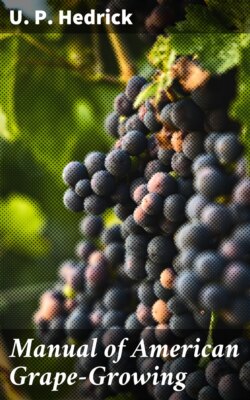Читать книгу Manual of American Grape-Growing - U. P. Hedrick - Страница 14
На сайте Литреса книга снята с продажи.
The Vulpina or river-bank grapes.
ОглавлениеThe North, too, has a wine-grape from which wines nearly equaling those of the southern Æstivalis are made. This is Vitis vulpina (V. riparia), the river-bank grape, a shoot of which is shown in Fig. 5, the most widely distributed of any of the native species. It grows as far north as Quebec, south to the Gulf of Mexico and from the Atlantic to the Rocky Mountains. Fully a century ago, a wine-grape of this species was cultivated under the name Worthington, but the attention of vineyardists was not turned to the Vulpinas until after the middle of the last century, when the qualities of its vines attracted the attention of French viticulturists. Phylloxera had been introduced from America into France and threatened the existence of French vineyards. After trying all possible remedies for the scourge, it was discovered that the insect could be overcome by grafting European grapes on American vines resistant to phylloxera. A trial of the promising species of New World grapes showed that vines of this species were best suited for the reconstruction of French vineyards, the vines being not only resistant to the phylloxera but also vigorous and hardy. At present, a large proportion of the vines of Europe, California and other grape-growing regions are grafted on the roots of this or of other American species, and the viticulture of the world is thus largely dependent on these grapes.
Fig. 5. A shoot of Vitis vulpina.
The French found that a number of the Vulpina (Riparia) grapes introduced for their roots were valuable as direct producers for wines. The fruits of this species are too small and too sour for dessert, but they are free from the disagreeable tastes and aromas of some of our native grapes and, therefore, make very good wines. The best known of the varieties of this species is the Clinton, which is generally thought to have originated in the yard of Dr. Noyes, of Hamilton College, Clinton, New York, about 1820. It is, however, probably the Worthington, of which the origin is unknown, renamed. There are possibly a hundred or more grapes now under cultivation wholly or in part from Vulpina, most of them hybrids with the American Labrusca and the European Vinifera, with both of which it hybridizes freely.
